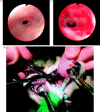Investigation of nasal disease in the cat--a retrospective study of 77 cases
- PMID: 15265480
- PMCID: PMC10822601
- DOI: 10.1016/j.jfms.2003.08.005
Investigation of nasal disease in the cat--a retrospective study of 77 cases
Abstract
A retrospective study was undertaken to determine the prevalence of different diseases in cats referred for investigation of chronic nasal disease, to identify historical, clinical and diagnostic features which may assist in making a diagnosis, and to provide information pertaining to outcome in these cats. Diagnoses included neoplasia (30 cases), chronic rhinitis (27), foreign body (8), nasopharyngeal stenosis (5), Actinomyces infection (2), nasal polyps (2), stenotic nares (2), and rhinitis subsequent to trauma (1). The most common neoplasia was lymphosarcoma (21 cases), with a median survival of 98 days for cats treated with multiagent chemotherapy. Cats with neoplasia were older on average than the other cats, and were more likely to be dyspnoeic and have a haemorrhagic and/or unilateral nasal discharge than cats with chronic rhinitis. Cats with neoplasia were more likely to have radiographic evidence of nasal turbinate destruction, septal changes, or severe increases in soft tissue density than cats with chronic rhinitis. It was unusual for cats with diseases other than neoplasia to be euthanased as a result of their nasal disease.
Figures






References
-
- Allen H.S., Broussard J., Noone K. Nasopharyngeal diseases in cats: a retrospective study of 53 cases (1991–1998), Journal of the American Veterinary Medical Association, 35, 1999, 457–461. - PubMed
-
- Boswood A., Lamb C.R., Brockman D.J., Mantis P., Witt A.L. Balloon dilation of nasopharyngeal stenosis in a cat, Veterinary Radiology and Ultrasound, 44, 2003, 53–55. - PubMed
-
- Caniatti M., Roccabianca P., Ghisleni G., Mortellaro C.M., Romussi S., Mandelli G. Evaluation of brush cytology in the diagnosis of chronic intranasal disease in cats, Journal of Small Animal Practice, 39, 1998, 73–77. - PubMed
-
- Cape L. Feline idiopathic chronic rhinosinusitis: A retrospective study of 30 cases, Journal of the American Animal Hospital Association, 28, 1992, 149–155.
-
- Cox N.R., Brawner W.R., Powers R.D., Wright J.C. Tumors of the nose and paranasal sinuses in cats: 32 cases with comparison to a national database (1977 through 1987), Journal of the American Animal Hospital Association, 27, 1991, 339–347.
Publication types
MeSH terms
LinkOut - more resources
Full Text Sources
Medical
Miscellaneous

